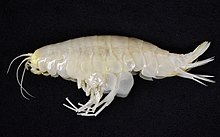Alicella giganteais the largestspeciesofamphipodever observed, with some individuals reaching up to 34 centimetres (13 in) long.[2][3]The average length ofA. gigantearanges from 72.5 to 141.0 millimetres, and its weight ranges from 4.2 to 45 grams.[4]Comparatively to other amphipods, the A. gigantea grows at a much faster rate.[4]Formerly included in the familyLysianassidae,a new family,Alicellidae,was erected in 2008 forAlicellaand five related genera.[5]The species lives only at great depths; the first specimens were collected at the end of the 19th century from theMadeira Abyssal Plain,and subsequent specimens have been found in otherabyssal plainsof both theAtlanticandPacific Oceans,[6]as well as from theKermadec Trenchin the southwest Pacific.[3]One specimen was found in the stomach of ablack-footed albatross,but is thought to have been dead before it was eaten.[6]
| Alicella gigantea | |
|---|---|

| |
| Scientific classification | |
| Domain: | Eukaryota |
| Kingdom: | Animalia |
| Phylum: | Arthropoda |
| Class: | Malacostraca |
| Order: | Amphipoda |
| Parvorder: | Lysianassidira |
| Superfamily: | Alicelloidea |
| Family: | Alicellidae |
| Genus: | Alicella Chevreux, 1899 |
| Species: | A. gigantea
|
| Binomial name | |
| Alicella gigantea | |
The size of this species of amphipod is hypothesized to be connected to oxygen availability.[7]A. giganteahave gills on coxa 7 and tubiliform accessory lobes.[7]These additional structures allow forA. giganteato absorb more oxygen, which is a known contributor to gigantism.[7]The size ofA. giganteaalso allows them to avoid being preyed on by potential predators such asNotoliparis kermadecensis,a liparid that preys on smaller amphipods.[7]
References
edit- ^"Alicella giganteaChevreux, 1899 ".Integrated Taxonomic Information System.RetrievedJanuary 10,2012.
- ^J. L. Barnard & Camilla L. Ingram (1986). "The supergiant amphipodAlicella giganteaChevreux from the North Pacific Gyre ".Journal of Crustacean Biology.6(4):825–839.doi:10.2307/1548395.JSTOR1548395.
- ^abRebecca Morelle(2 February 2012)."'Supergiant' crustacean found in deepest ocean ".BBC News.Retrieved4 February2012.
- ^abLi W, Wang F, Jiang S, Pan B, Chan J and Xu Q (2021) The Adaptive Evolution and Gigantism Mechanisms of the Hadal “Supergiant” Amphipod Alicella gigantea. Front. Mar. Sci. 8:743663. doi: 10.3389/fmars.2021.743663
- ^J. K. Lowry & C. de Broyer (2008)."Alicellidae and Valettiopsidae, two new callynophorate families (Crustacea: Amphipoda)"(PDF).Zootaxa.1843:57–66.doi:10.11646/zootaxa.1843.1.5.
- ^abClaude de Broyer & Michael H. Thurston (1987). "New Atlantic material and redescription of the type specimens of the giant abyssal amphipodAlicella giganteaChevreux (Crustacea) ".Zoologica Scripta.16(4):335–350.doi:10.1111/j.1463-6409.1987.tb00079.x.S2CID86306559.
- ^abcdJamieson, A. J.; Lacey, N. C.; Lörz, A. -N.; Rowden, A. A.; Piertney, S. B. (2013-08-01)."The supergiant amphipod Alicella gigantea (Crustacea: Alicellidae) from hadal depths in the Kermadec Trench, SW Pacific Ocean".Deep Sea Research Part II: Topical Studies in Oceanography.Deep-Sea Biodiversity and Life History Processes.92:107–113.doi:10.1016/j.dsr2.2012.12.002.ISSN0967-0645.
- Li W, Wang F, Jiang S, Pan B, Chan J and Xu Q (2021) The Adaptive Evolution and Gigantism Mechanisms of the Hadal “Supergiant” Amphipod Alicella gigantea. Front. Mar. Sci. 8:743663. doi: 10.3389/fmars.2021.743663